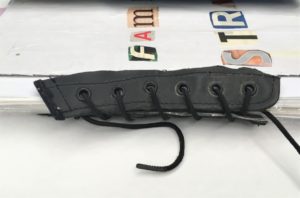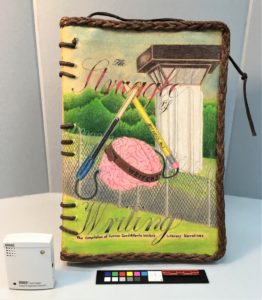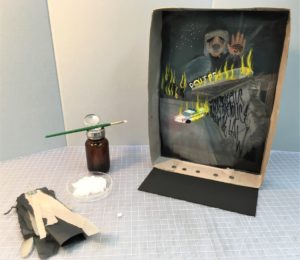Voices From the Other Side is a student-curated exhibition of artists’ books and writings from Rose Library’s Phillips State Prison Book Project Records on view now on Level 1 of the Robert W. Woodruff Library.
Many of these artists’ books were created by students in Bill Taft’s creative non-fiction classes, taught under the auspices of the Common Good Atlanta prison education initiative. Taft and Emory professor, Sarah Higinbotham, founded the project ten years ago when they were graduate students to provide ”incarcerated people with broad, democratic access to higher education so they can develop a better understanding of both themselves and the societal forces at work around them.”
After reading the memoir, March: Book One by John Lewis, the students each wrote an essay about their childhood and paths to literacy. When Taft found that his students were not particularly interested in revising their essays, he decided to introduce writing and bookbinding techniques as a means of making the assignment more compelling. Taft “challenged the men to make their own books using discarded materials. Just as Sumerians, Egyptians, Chinese, and Europeans used available resources for a writing surface, so would the men.”
Artifacts in this exhibit meet that challenge: book structures represented include scrolls, Chinese side-stab bindings, and western codices. The side-sewn anthologies were prepared using a drill, fashioned from a broken metal eye glass frame, and melted to a point with fire generated by arcing an electrical socket. One book is sewn through the eyelets of a leather boot fragment.
The students were remarkably resourceful in their use of cover materials. Mirage, the central artist behind The Struggle of Writing, coated a torn bed sheet with a layer of floor wax and crafted the ornamental, braided faux-leather border out of toilet paper and glue, stained with coffee. Another artist, Icarus, describes mixing a glue substitute when he did not have access to his usual art supplies during a prison-wide lock down. “Using a soup bowl to mix up a paste made out of window epoxy, cornstarch powder, state-issued toothpaste, instant lemonade powder, a bar of soap and floor wax, I created the base to my own adhesive.”
The stability and light-fastness of these unusual materials is unknown, so exhibition and long-term preservation strategies will include careful environmental monitoring of temperature, relative humidity, and light exposure (facilitated by devices as shown in the photo of The Struggle of Writing).
Threads That Bind Us presented an interesting conservation for exhibition challenge: the structure of this work is a side-sewn gathering of photo-copied essays covered in glue and paper composite board covered with textile (sheets or shirts), then presented in a box with art on the inside, outside, top, and bottom of the covers. Curators Kassie Sarkar, Greta Goldbart, and Jacob Ruhkamp requested that the front/top box be displayed in a way that allows for viewing from all sides. Traditional book mounts would have obscured one side or the other, so we set-up an experiment with a rare earth magnet mounting system. This experiment successfully tested for stability against vibrations from foot traffic and library carts. The next step will be to cover the magnets with a Japanese tissue matching the artifact.
Julie Newton, Assistant Conservator-Emory Libraries



